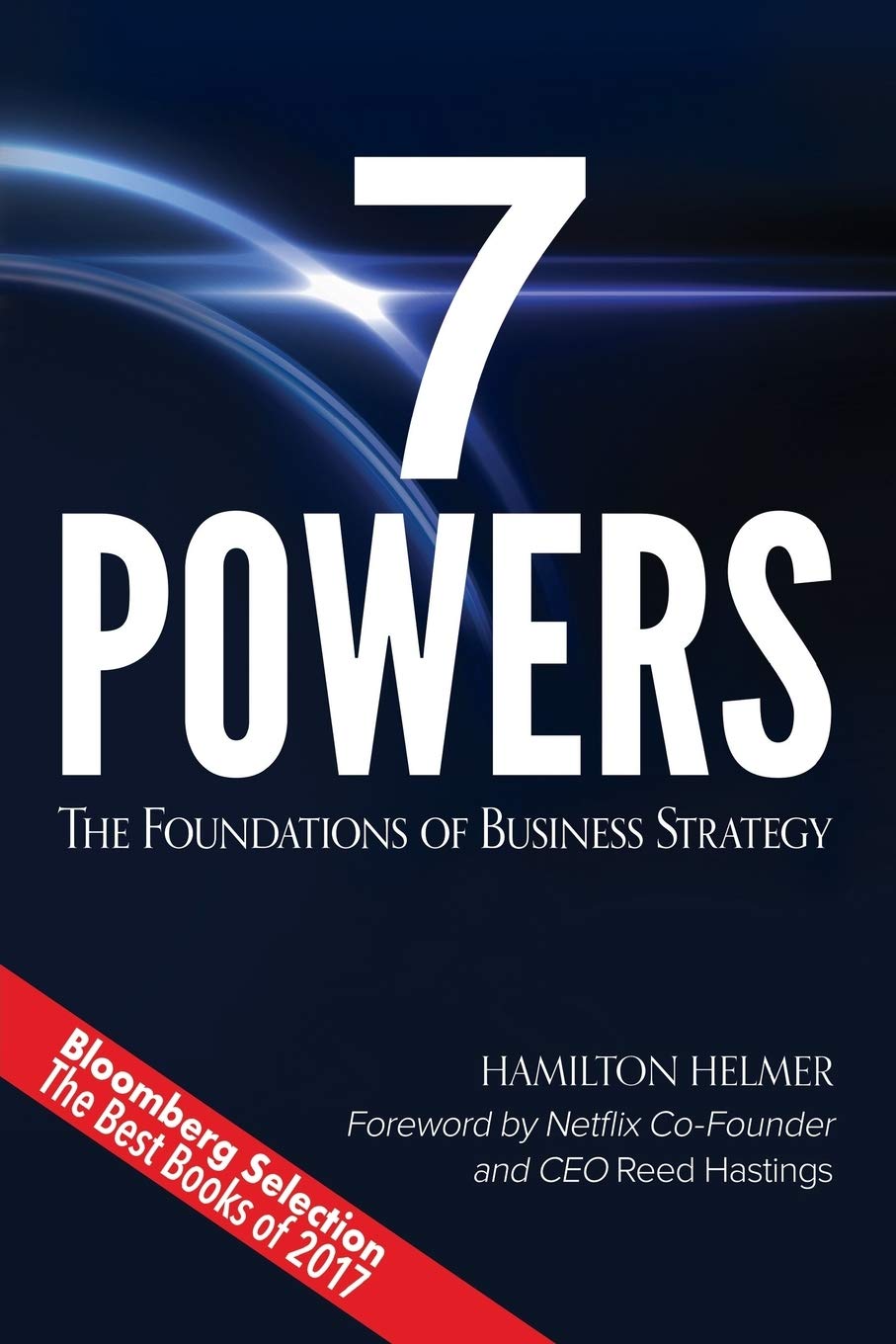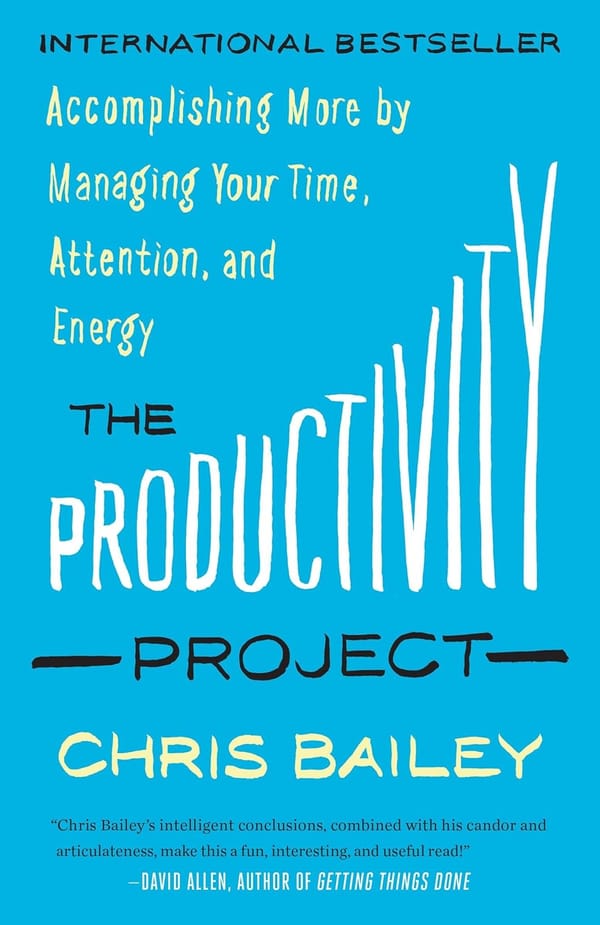7 Powers - The Foundations of Business Strategy - Book Notes
If you enjoyed my review, consider supporting me by using the affiliate links below to purchase the book. Your kindness fuels my passion for sharing captivating reads with you!
🚀 The Book in 3 Sentences
- "7 Powers" emphasizes the critical importance of identifying and leveraging unique business powers to maximize fundamental value.
- The book outlines seven distinct powers—Scale Economies, Network Economies, Counter-Positioning, Switching Costs, Branding, Cornered Resource, and Process Power—each with its own set of benefits and barriers.
- The key takeaway is to strategically diversify power sources, prioritize sustainability, and continuously innovate, all with the ultimate goal of creating and maintaining a competitive advantage that delivers superior customer value.
👱 Who Should Read it?
"7 Powers" is recommended for business leaders, entrepreneurs, and strategists seeking a deep understanding of foundational business strategies. Executives looking to enhance their company's competitive position, startups aiming to navigate market entry, and anyone interested in the dynamics of persistent differential returns in business will find valuable insights. Additionally, professionals in the fields of business strategy, management, and innovation will benefit from the book's comprehensive exploration of various powers and their strategic applications.
🍀 How the Book Changed Me
I read this book as a preparation for starting my own business and I'm sure it will help me creating a strategy to make use of the 7 Powers.
✍️ Top 3 Quotes
- "Strategy has one and only one objective: maximizing potential fundamental business value."
- "Power, the potential to realize persistent differential returns, is the key to value creation. Power is created if a business attribute is simultaneously: Superior, Significant, and Sustainable—the improvement must be largely immune to competitive arbitrage."
- "Power arrives only on the heels of invention. If you want your business to create value, then action and creativity must come foremost. Invention has a powerful one-two value punch: it both opens the door for Power and also propels market size."
🔨 3 Action Points
- Identify and Leverage Your Unique Power:
Begin by conducting a thorough analysis of your business operations and market position to identify a specific type of power that aligns with your strengths. Develop strategies that maximize the benefits and fortify barriers to entry. Regularly reassess the competitive landscape for ongoing relevance. - Diversify Power Sources for Long-Term Resilience:
Acknowledge the dynamic nature of business growth and market conditions, diversifying power sources to adapt to changing landscapes. Evaluate risks and opportunities associated with each power type, fostering innovation within your organization for ongoing resilience. - Prioritize Sustainability and Customer Value:
Emphasize the sustainability of your chosen power, ensuring it remains resilient amid market changes. Prioritize delivering superior customer value by aligning with the 3 S's - superiority, significance, and sustainability. Engage in continuous customer dialogue to adjust your power strategy dynamically.
📗 Summary & Notes
Introduction to Strategy:
A strategic framework, as outlined in the book emphasizes the necessity for simplicity without oversimplification. The study of strategy involves understanding the fundamental determinants of potential business value. It delves into statics, "being there," examining what makes a business durably valuable, and dynamics, "getting there," exploring the developments that led to its attractive state. Power, the central concept, is defined as the set of conditions creating the potential for persistent differential returns. Strategy, then, is portrayed as a route to maintaining power in significant markets.
The 7 Powers:
- Scale Economies
- Network Economies
- Counter-Positioning
- Switching Costs
- Branding
- Cornered Resource
- Process Power
Dual Attributes:
The book introduces the dual attributes of power - benefit and barrier. Benefit manifests as conditions that materially augment cash flow, encompassing increased prices, reduced costs, or lessened investment needs. The barrier ensures that these benefits persist, preventing competitors from engaging in value-destroying arbitrage. This dual nature of power underlines its importance and complexity, making it both hard to achieve and crucial for sustained advantage.
Power 1 - Scale Economies:
In the realm of scale economies, the book emphasizes the significance of size, encapsulated in the phrase "size matters." Reduced unit costs with increased business size are termed as scale economies. The surplus leader margin (SLM) is introduced as a measure of the profit margin a business with power can expect, considering scale economy intensity and scale advantage. Various sources of scale economies, such as volume/area relationships, distribution network density, learning economies, and purchasing economies, are explored, showcasing the multifaceted nature of power.
- Benefit: Scale Economies offer reduced costs, leading to improved cash flow.
- Barrier: Prohibitive costs of share gains create a competitive cul-de-sac, establishing a barrier to entry.
Power 2 - Network Economies:
Network economies, another pivotal concept, highlight the value enhancement as more customers join a network. Winner-take-all dynamics, boundedness, and decisive early product introduction characterize industries with strong network economies. The book introduces the concept of indirect network effects, emphasizing the improved value proposition resulting from exclusive complements. The surplus leader margin equation is presented to quantify the value proposition in network economies.
- Benefit: A company in a leadership position with Network Economies can charge higher prices than its competitors, due to the higher value resulting from more users.
- Barrier: The unattractive cost/benefit of gaining share acts as a barrier, making it extremely costly for competitors to challenge the leader.
Power 3 - Counter-Positioning:
Counter-positioning emerges as a strategy where a newcomer adopts a superior business model that the incumbent does not mimic due to anticipated damage. This involves developing a new, superior approach with high substitutability for existing products, where the incumbent has little prospect for power. Counter-positioning is defined by three conditions - a new superior approach, high substitutability, and the incumbent's lack of power in the new business.
- Benefit: The new business model is superior, allowing for lower costs and/or the ability to charge higher prices.
- Barrier: Collateral damage, or the expected damage to the existing business, acts as a barrier, deterring the incumbent from adopting the new model.
Power 4 - Switching Costs:
Switching costs arise when consumers value compatibility across multiple purchases over time, providing a cost advantage to the power holder. The book details financial, procedural, and relational switching costs, highlighting their role in creating a barrier to competitors. It emphasizes that switching costs offer no benefit if no additional related sales are made to the customer, presenting a nuanced perspective on their impact.
- Benefit: A company with embedded Switching Costs can charge higher prices to its current customers.
- Barrier: Competitors must compensate customers for Switching Costs, making it unattractive for them to challenge the power holder.
Power 5 - Branding:
Branding, a potent source of power, empowers businesses to command higher prices, driven by two key factors:
- Affective Valence: Brands evoke positive emotions, allowing them to charge premium prices even when products are objectively similar. For example, the emotional connection to Coke may lead consumers to pay more than an unknown cola brand.
- Uncertainty Reduction: Branding provides a sense of assurance, reducing customer uncertainty about product quality. Customers often choose well-branded items, like Bayer aspirin, for the peace of mind associated with consistent quality, even when alternatives are more affordable.
The book cautions of against challenges of branding like brand dilution, counterfeiting, changing consumer preferences, geographic boundaries, narrowness, and non-exclusivity.
- Benefit: A business with branding can charge a higher price for its offering due to affective valence or uncertainty reduction.
- Barrier: Building a strong brand over time, characterized by hysteresis, serves as the key barrier to entry. Challenges like brand dilution, counterfeiting, and changing consumer preferences also act as barriers.
Power 6 - Cornered Resource:
Cornered resource is introduced as a strategy where a firm has preferential access to a coveted asset that can independently enhance value. The book outlines tests for a cornered resource, including idiosyncratic, non-arbitraged, transferable, ongoing, and sufficient attributes. It explores various forms of cornered resources, such as access to valuable patents, required inputs, or cost-saving production approaches.
- Benefit: The cornered resource provides uniquely different benefits, such as preferential access to a valuable patent, a required input, or a cost-saving production approach.
- Barrier: The general term for the barrier associated with a cornered resource is "fiat," which comes by decree, either general or personal.
Power 7 - Process Power:
Process power is defined as embedded company organization and activity sets that enable lower costs and/or superior products due to process improvements. The book discusses the barriers to process power, emphasizing complexity and opacity, and highlights the rarity of process power due to the infrequency of these barriers.
- Benefit: Process power allows a company to have lower costs and/or superior products due to the effectiveness of its embedded processes.
- Barrier: The complexity and opacity of the processes serve as a barrier, making it challenging for competitors to replicate the embedded activity sets.
The Importance of Invention:
The author underscores the pivotal role of invention in business strategy. The book argues that power, a key driver of value creation, is intricately linked to invention—whether it be the creation of a groundbreaking product, a revolutionary business model, or an innovative brand. Planning alone is deemed insufficient; it is through inventive actions and creative endeavors that businesses unlock the door to power, fostering both market size expansion and the potential for sustained competitive advantage.
Compelling Value:
Compelling value is the ability of a product to elicit a "gotta have" response from customers. The book identifies three paths to compelling value:
- Capabilities-Led Compelling Value:
Companies leverage existing capabilities to create products meeting unmet customer needs. The challenge lies in the inherent uncertainty of customer needs and the necessity of early establishment of a formidable barrier. - Customer-Led Compelling Value:
Multiple players recognize an unmet need, but the solution remains unknown. The difficulty lies in accurately identifying and satisfying the customer's unknown needs. - Competitor-Led Compelling Value:
A competitor introduces a successful product, prompting the need for the innovator to outperform in features and desirability. The uncertainty here involves whether new features are attractive enough for significant market share gains and if existing competitors can be sufficiently delayed in responding.
Strategy Implementation:
The book underscores the importance of understanding which power type to pursue at different stages of a business's growth. It emphasizes that for each power type, a business must pursue a model that promises industry economics while offering a differentially attractive product to gain customer share.
Stages of Strategy Implementation:
- Origination Stage:
- Occurs before a company reaches the compelling value threshold.
- Focuses on Counter-Positioning and Cornered Resource strategies.
- Key considerations involve minimizing collateral damage to the incumbent and assessing the potential value of protected rights.
- Takeoff Stage:
- Characterized by explosive growth and favorable terms for gaining market share.
- Ideal for implementing Scale Economies, Network Economies, and Switching Costs strategies.
- Hysteresis, collateral damage, and the cost of gaining share are critical factors to consider during this stage.
- Stability Stage:
- Signifies a period of slowed but considerable growth.
- Ideal for implementing Process Power and Branding strategies.
- Focus shifts from gaining share to optimizing value as market dynamics become more predictable.
The Value Axiom and 3 S's:
The value axiom posits that the sole objective of strategy is maximizing potential fundamental business value. The book introduces the 3 S's of power - superiority, significance, and sustainability, emphasizing their role in creating value through persistent differential returns.



